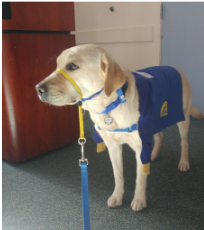Written By: Hannah Nasluchacz, Staff Writer
PUPPIES: Raising dogs to become service dogs is a challenging – yet necessary and worthwhile task.
The basic steps a prospective service dog goes through to be fully ready for their service duties can be broken down into four parts:
The first part is breeding the right type of dog; only certain energies and personalities of dogs can succeed in a training program, so the organization tries to increase the chances of success by selectively breeding two dogs that are ideal together. These dogs are tested for temperament prior to their breeding.
Then – the puppy is given to the puppy raisers. During an eighteen month period, puppy raisers crate train and teach the dogs obedience commands and socialize them to be comfortable with different environments. These environments include surfaces like grates and glass as well as noises like ice machines or fog horns. This training is necessary to ensure the service dogs do not react to noises and know when to alert their owners to possible dangers and barriers.
Following the eighteen month extensive training by the puppy raisers, the dogs go back to the service dog training organization to be analyzed and sent for training in a specialized position.
Finally, the dogs complete their training and graduate, being awarded a service dog certificate and given to a specific owner. Per the Americans with Disability Act, “a service animal is a dog that is individually trained to do work or perform tasks for a person with a disability. Generally, entities must permit service animals to accompany people with disabilities in all areas where members of the public are allowed to go.”
During their career, service dogs work for an average of six to eight years and eventually retire. Keep in mind, the likelihood of a prospective dog having a career as a service animal is slim, and most dogs do not make it through the difficult training process. Even with the best training programs, the chances of increasing the percentage of dogs graduating is not likely due to the need for a specific personality. Just like humans, dogs are individuals and there are no two that are the same: this is why organizations breed dogs specifically for the service dog career, aiming to create personality and energy that can pass the program.
The valuable process of training service dogs is close to my heart, because my family raised a loving service dog – Laurel the Sixth. We worked extremely hard to potty train her, teach basic obedience, and crate train her, which is where the dog is trained to eat, sleep, and to stay when people are gone from the house.
My family got her when she was a puppy; we traveled to Oceanside to pick her up from the organization we trained her through. We already had dogs not as disciplined as Laurel needed to be, and training her with the example of her less-disciplined counterparts was challenging. Regardless, when she put on her leash and her vest, Laurel knew that she was working. As a result of living with our other dogs, Laurel gained a positive personality outside of work too. While working, she needed to be focused and calm, but when the vest and leash came off, Laurel knew that she could be like any other dog.
Yet, we eventually needed to give Laurel to a prospective owner in need. By the end of her training, we were attached to her, but in our hearts we knew that she was ready to leave; she was going on to help a lady, who needed her more than we did. During the training process, the organization Canine Companion for Independence helped us, holding weekly classes with the dog to initiate a new section of training. Ultimately, we were all proud of Laurel’s success, and the hard work of raising and training her truly paid off.
Service dogs maintain a lot of expenses, particularly with breeding, training, and medical care. Without people volunteering to raise puppies and donating to organizations, service dogs would cost thousands of dollars for a person in need, if their insurance did not provide coverage. Providing his input, Poly student Joey Subriar (11) claimed that if a service dog was important in someone’s life “then it should be free” – the wellness of a person should not be in the hands of money. According to Hayden McIntosh (11), service dogs are “needed to help, [and] people could die if they don’t have [them].”
Canine Companions for Independence is not the only organization that lessens the expense of service dogs through their dedicated volunteers. Other companies providing volunteers include Guide Dogs of America and Helping Paws. People need to be aware that service dogs are highly important to their owners and be willing to provide support both mentally and physically as needed. Perhaps you too can take the challenge of raising and training one of these amazing animals. It is absolutely worth the sacrifices.

Laurel standing at her graduation.

